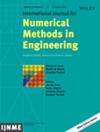三维泊松方程的稳健切割单元有限元方法
IF 2.7
3区 工程技术
Q1 ENGINEERING, MULTIDISCIPLINARY
International Journal for Numerical Methods in Engineering
Pub Date : 2024-08-06
DOI:10.1002/nme.7577
引用次数: 0
摘要
摘要 本文介绍了一种切割单元有限元方法,该方法采用统一的笛卡尔轴对齐网格,用于求解光滑三维域中的泊松方程。通过 Delaunay 三角剖分法弱化了 Neumann 边界条件,而通过投影法强化了 Dirichlet 边界条件。一组数值模拟表明,所提出的方法是稳健的,并保持了相应的体拟合方法所预期的渐进收敛速率。本文章由计算机程序翻译,如有差异,请以英文原文为准。
A robust cut-cell finite element method for Poisson's equation in three dimensions
This article documents a cut-cell finite element method for solving Poisson's equation in smooth three-dimensional domains using a uniform, Cartesian axis-aligned grid. Neumann boundary conditions are imposed weakly by way of a Delaunay triangulation, while Dirichlet boundary conditions are imposed strongly using a projection method. A set of numerical simulations demonstrates the proposed method is robust and preserves the asymptotic rate of convergence expected of corresponding body-fitted methods.
求助全文
通过发布文献求助,成功后即可免费获取论文全文。
去求助
来源期刊
CiteScore
5.70
自引率
6.90%
发文量
276
审稿时长
5.3 months
期刊介绍:
The International Journal for Numerical Methods in Engineering publishes original papers describing significant, novel developments in numerical methods that are applicable to engineering problems.
The Journal is known for welcoming contributions in a wide range of areas in computational engineering, including computational issues in model reduction, uncertainty quantification, verification and validation, inverse analysis and stochastic methods, optimisation, element technology, solution techniques and parallel computing, damage and fracture, mechanics at micro and nano-scales, low-speed fluid dynamics, fluid-structure interaction, electromagnetics, coupled diffusion phenomena, and error estimation and mesh generation. It is emphasized that this is by no means an exhaustive list, and particularly papers on multi-scale, multi-physics or multi-disciplinary problems, and on new, emerging topics are welcome.

 求助内容:
求助内容: 应助结果提醒方式:
应助结果提醒方式:


